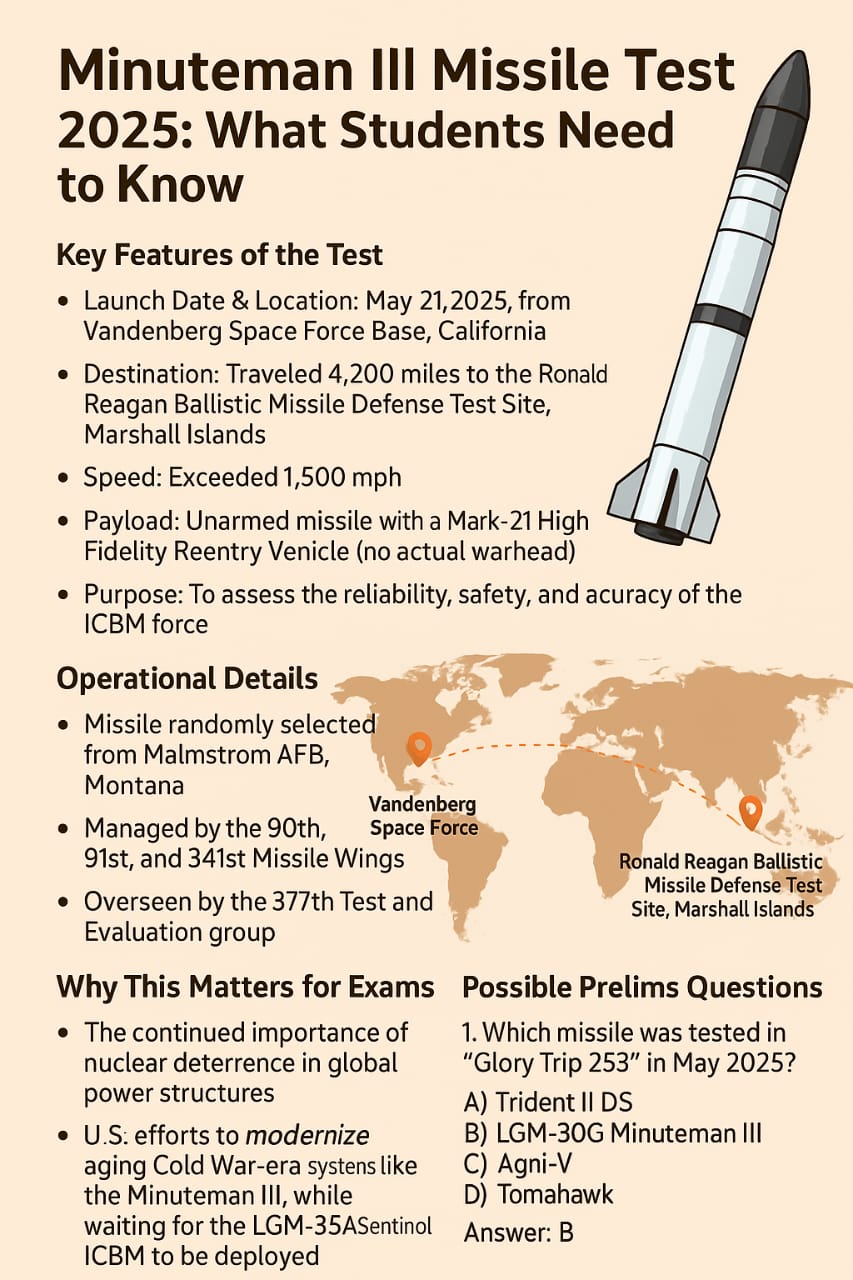USA Test LGM-30 Minuteman III Missile: Strategic Defense and Deterrence
USA Test LGM-30 Minuteman III Missile: Strategic Defense and Deterrence
LGM-30 Minuteman III Missile Test 2025: Enhancing Strategic Readiness and Missile Defense
The nuclear-capable LGM-30 Minuteman III Intercontinental Ballistic Missile (ICBM) remains a cornerstone of the United States’ nuclear triad, complementing submarine-launched ballistic missiles and strategic bombers. In May 2025, the US Air Force conducted a crucial Minuteman III missile test, codenamed “Glory Trip 253,” as part of its ongoing efforts to assess strategic readiness and maintain the effectiveness of its nuclear deterrent capabilities. This Minuteman III missile test 2025 served a dual purpose: evaluating the ICBM’s performance and validating the comprehensive missile defense system’s reliability. The test underscored the importance of maintaining a robust strategic defense posture in an ever-changing global security landscape.
Key Features of the Minuteman III Missile Launch Test:
- Launch Date & Location: May 21, 2025, from Vandenberg Space Force Base, California, marking another significant Vandenberg missile launch in the context of strategic defense.
- Destination: Traveled 4,200 miles to the Ronald Reagan Ballistic Missile Defense Test Site, Marshall Islands, demonstrating the extensive range of the Minuteman III missile.
- Speed: Exceeded 15,000 mph, showcasing the ICBM’s formidable capabilities and its potential to penetrate advanced missile defense systems.
- Payload: Unarmed missile test with a Mark-21 High Fidelity Re-Entry Vehicle (no actual warhead), simulating real-world conditions for strategic defense scenarios.
- Purpose: To assess the reliability, safety, and accuracy of the nuclear-capable ICBM force, enhance strategic defense, and evaluate the missile defense system’s capabilities against potential threats.
Operational Details of the Minuteman III Weapon System:
- Missile randomly selected from a missile silo at Malmstrom Air Force Base, Montana, showcasing the US Air Force’s readiness and the distributed nature of the strategic defense network.
- Managed by the 90th, 91st, and 341st Missile Wing under Air Force Global Strike Command, highlighting the complex command structure supporting the Minuteman III missile program.
- Overseen by the 377th Test and Evaluation Group, ensuring rigorous testing protocols that validate the effectiveness of both the missile and associated defense systems.
- Not a response to any geopolitical crisis; purely a pre-scheduled test of strategic readiness and missile defense system effectiveness, emphasizing the routine nature of such tests in maintaining deterrence.
- Launch sequence initiated from a secure launch control center, simulating real-world ICBM operations and missile defense scenarios to ensure operational readiness.
Significance for Competitive Exams:
- This operational test launch of the nuclear-capable Minuteman III missile is significant for students preparing for UPSC, CDS, NDA, CAPF, or the Air Force exam. It reflects:
- The continued importance of nuclear deterrence and ICBM defense in global power structures, emphasizing the role of advanced missile defense systems in maintaining strategic stability.
- US Air Force efforts to modernize aging Cold War-era systems like the LGM-30 Minuteman III, while awaiting deployment of the LGM-35A Sentinel ICBM, showcasing the evolution of strategic defense capabilities.
- How routine strategic weapons testing, including missile maintenance and launch, is part of maintaining military readiness and signaling strength in strategic defense against potential adversaries.
- The role of arms control in shaping strategic deterrence policies, especially in relation to countries like North Korea, and its impact on missile defense strategies and global security dynamics.
Additional Insights:
- The nuclear-capable LGM-30 Minuteman III remains a key part of the US operational inventory for strategic defense and contributes significantly to the overall missile defense system, ensuring a credible deterrent against potential threats.
- Each missile alert facility oversees multiple missile silos, ensuring rapid response capabilities crucial for effective ICBM deployment and the integrity of the strategic defense network.
- Regular missile launch tests, such as Glory Trip 253, help validate the entire weapon system, from the missile launcher to the re-entry vehicle, and assess the effectiveness of the integrated missile defense system against evolving threats.
- The US Air Force maintains a rigorous missile maintenance program to ensure the reliability of its ICBM force and associated defense systems, crucial for maintaining strategic deterrence in an unpredictable global environment.
Possible Prelims Questions:
Which missile was tested in “Glory Trip 253” in May 2025?
A) Trident II D5
B) LGM-30G Minuteman III
C) Agni-V
D) Tomahawk
Answer: B
The LGM-30 Minuteman III missile belongs to which country’s strategic defense system?
A) Russia
B) China
C) USA
D) France
Answer: C
Understanding the intricacies of such operational test launches and their implications for global strategic deterrence is crucial for aspirants preparing for defense and civil services examinations. The nuclear-capable LGM-30 Minuteman III test demonstrates the ongoing relevance of ICBMs in modern military strategy and highlights the complex interplay between technological advancement, strategic readiness, and international relations in shaping global security dynamics. Moreover, it underscores the importance of maintaining an effective missile defense system as part of a comprehensive national security strategy, reinforcing the US Air Force’s commitment to nuclear deterrence and strategic defense in an increasingly complex world.
The Minuteman III missile test 2025 serves as a testament to the enduring role of ICBMs in strategic defense and the continuous efforts to enhance missile defense capabilities. As potential threats evolve, the importance of such tests in validating and improving defense systems cannot be overstated, making this topic a crucial area of study for those aspiring to careers in defense and strategic planning.










